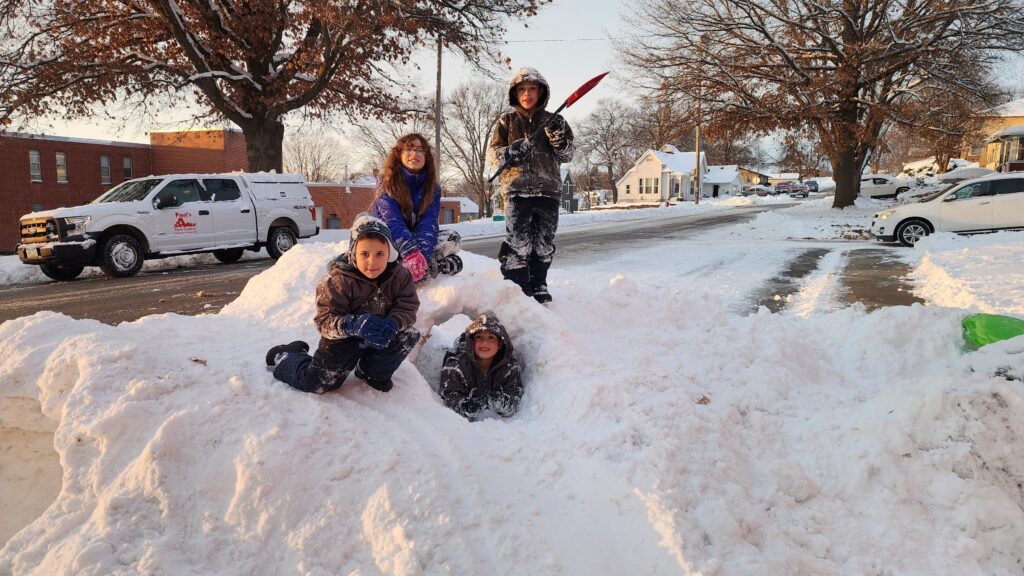ACGC High School Menu – January 2024


By Rich Wicks | Times Vedette
On Jan. 8, the Guthrie Center City Council met in regular session.
Mayor Mike Herbert discussed concerns with recent actions by a Utility Board trustee toward city staff. Dan Nickell was in attendance on behalf of the GCMU Board of Trustees. After much discussion, the consensus by the council was that this behavior would not be tolerated, and if there was another incident, the council would vote to have said trustee removed from the board.
City Clerk Kris Arrasmith shared the Library Board had recently approved a 5% salary increase for its staff effective Jan. 1 at its December meeting. She explained this increase was not included in the 2023/2024 budget and was approved by the MJB Library Board without a conversation with Arrasmith or the council prior to the meeting. The council instructed Arrasmith to give clarification to the library board president, Steve Bascom, on salary budgeting, timing, approvals and proper procedures.
Public Works Superintendent Darin Sloss provided his departmental report. He shared his department had been prepping for snow removal season, taking down holiday lights, and removing some trees. He also shared that the DNR was going to require an upgraded wastewater sampler. He had received a quote for a new sampler from GPM Environmental Solutions for $4,853. The council unanimously approved the request.
Arrasmith shared that city hall would be closing at noon on Wednesdays during the month of January so they can move forward with transitioning to the new financial software program. She will keep the council posted on the progress of the software migration.
As part of the consent agenda, the council approved a beer/liquor permit for Dollar General.
The council’s next regular meeting will be Monday, Jan. 22.

By Rich Wicks | Times Vedette
A benefit event for Jaya Fever will be held on Saturday, Feb. 3 at the Adair Fire Hall, sponsored by Adair Fire and Rescue and Good Shepherd Lutheran Church of Adair. The doors will open at 4:30 p.m., at which time the silent auction begins and carry-outs will be available. The on-site meal begins at 5 p.m., followed by a live auction at 6:30 p.m., and the closing of the silent auction at 7:30 p.m.
Fever was an ACGC High School senior in December 2022 when she was severely injured in a car accident on her way to school, suffering a traumatic brain injury (TBI). For the first six months following the accident, she resided in rehabilitation centers in Chicago and Omaha. Since then, she has undergone outpatient treatments and therapies in Des Moines and Omaha.
Jaya’s father, Pastor Kyle Fever, said, “There’s still a long road ahead of a lot of traveling and expensive treatments that aren’t covered always by insurance. There’s no clear end in sight yet. But she’s made great improvements, considering that we’re only a year out. The big goal for Jaya is that she still wants to go to college. She’s a great artist, and she originally wanted to be an art teacher. But now, after her experience, she thinks she wants to be a speech therapist. We’re so hopeful that she can live that life.”
The items available during the fundraiser auction will include many from the local community. A number of NFL football items are also expected including several autographed items from the Minnesota Vikings and four tickets to a Vikings game. Items from the San Francisco 49ers, the Green Bay Packers, the Kansas City Chiefs, the Chicago Bears, and the Detroit Lions will also be included from players such as Brock Purdy, George Kittle, Patrick Mahomes, Justin Jefferson, Kirk Cousins, T.J. Hockenson, T.J. Edwards, Jack Campbell and yet-to-be-determined players from the Packers. n

By Rich Wicks | Lake Panorama Times
“Watch out for deer” is common advice in Iowa, often said both as a cautionary reminder to drive carefully and as a way of indicating, “I care about you.” As more roads and homes are built, encounters with deer are inevitable. But it wasn’t always this way.
When settlers were first arriving in the territory that would eventually become Iowa, deer were plentiful, according to data shown on the Iowa DNR website. But throughout the 1800s, the deer population was hunted extensively, and the population plummeted. In 1898, the 27th General Assembly provided complete protection for deer by closing the hunting season year-round. By this time, deer were nearly extinct in most areas of the state.
Deer were re-established in Iowa through the escape of animals from captive herds, trapping and transplanting programs of the Iowa Department of Natural Resources, and the immigration of animals from neighboring states. In 1894, 35 whitetails escaped from a captive herd in Avoca, which provided the nucleus for future herds in western Iowa. In the early 1920s, about 60 deer escaped from a farm in Washington County and became established along the Skunk River. Another herd was established in Boone County at Ledges State Park in 1928 when two deer, purchased from Minnesota, were released. In 1947, the first statewide population estimate was made with deer herds reported in 58 counties containing an estimated 1,650 animals. Deer herds were reported in 89 counties in 1950, and the population estimate was expanded to 13,000. In 2020, the statewide estimate was 445,000.
The rapid rise of Iowa’s deer population has led to concerns of crop damage when deer feed on corn, soybeans or other crops. Deer also cause damage in gardens and yards. Because of the swelling population and lack of natural predators, hunting is considered the best means to control the population. Without adequate hunting, the number would be balanced only through disease, starvation and roadkill incidents.
Local DNR officer Jeremy King pointed out that, although some people oppose hunting, animals harvested through hunting generally do not suffer long, whereas some of the natural diseases that arise in overpopulated herds lead to animals undergoing a long, painful death. The latest statewide harvest data shows that, for the 2019-2020 season, hunters harvested 109,544 deer in Iowa.
The whitetail deer situation at Lake Panorama mirrors the statewide status. Lane Rumelhart, project manager for the Lake Panorama Association, provided information on efforts to control the local deer population and minimize related problems.
“We have a hunting program for controlling the population, and we strongly recommend our members do not feed the deer,” Rumelhart said. “Obviously, feeding the deer is going to attract them to your house, and they’re going to stay in that general area more frequently, and you’re going to anger your neighbors. It’s best to just let the deer roam freely and find their food on their own.”
Rumelhart also discourages residents from putting out salt or mineral blocks for the same reason.
According to Rumelhart, the LPA and DNR have teamed up to develop specific hunting zones at the lake. The zones are changed periodically based on deer population changes, so Rumelhart encourages interested hunters to log onto the LPA website and then check in the Hunting folder for the current map of approved deer hunting zones.
“You have to be a member to sign up, or a guest of a member. It’s free for members but costs $50 for guests to register, and you have to sign up under a member who is registered to hunt,” Rumelhart said. Each member can have up to three non-member guests sign up under the member’s name.
“We typically get around 100 members signed up every year, and they shoot anywhere from 120 to 150 deer, so that program continues to be really successful for us,” he said. “We’d like to harvest over 100 each year. That number doesn’t seem to fluctuate much, and we’re really happy with it.”
Rumelhart notes that residing at Lake Panorama doesn’t offer any special permission. Hunters are still required to have a tag to hunt a deer and must be within one of the designated hunting zones. Deer tags can be obtained from any approved vendor in the state, including the LPA office.
Iowa has a variety of deer hunting seasons. For the 2023-2024 season, these include: Youth, Sept. 16 – Oct. 1
Disabled Hunter, Sept. 16 – Oct. 1
Archery, Oct. 1 – Dec. 1 AND Dec. 18 – Jan. 10
Muzzleloader Early: Oct. 14-22, Late: Dec. 18 – Jan. 10
Shotgun First: Dec. 2-6, Second: Dec. 9-17
Nonresident Holiday Dec. 24 – Jan. 2
Population Management, January Antlerless, Jan. 11-21
Excess Tag January Antlerless, Jan. 11-21.
Shooting hours for all deer seasons are one half-hour before sunrise to one half-hour after sunset.
Rumelhart says he receives questions at times about how to deal with a dead deer on an LPA member’s property.
“If a deer dies on your property, then you need to call one of our Animal Nuisance control specialists,” he said. “We have those listed on our vendor list. Those folks can remove that animal for a fee.”
Rumelhart says, if feasible, the property owner can drag the deer to the nearest edge of the timber and let nature take its course.
“There are a lot of animals and critters around here that will take care of a dead deer rather quickly,” he said. “Some folks may find that a bit gruesome, but that’s just nature, and that’s where we live.”
And if a deer is seen in the water?
“If there’s a deer in the lake, just call the office, and either security or maintenance will go out and try to get that deer out of the lake with our barge equipment.”
Rumelhart said if a sick or wounded animal is seen to always call the DNR.
“They’re legally responsible for taking care of those animals,” he said.
According to DNR officer King, the trends in the deer population at Lake Panorama are difficult to determine.
“People can drive around and see more deer than they did last year and assume the deer population is up. And, at the same time, another person might not see many deer and assume the population is down,” he said. “Really, the basis the DNR uses is harvest registrations. Anytime a hunter harvests a deer, they’re required by law to report the harvest by midnight the day after they kill it. Then we can look at that data and see what our harvest trend is like, and we can compare that to our hunter numbers as well.”
King said he worked with the DNR wildlife department and the LPA two years ago, and they came up with the deer management zone around the lake so that they were allotted their own number of tags.
“Prior to that, anytime a member of Lake Panorama wanted to hunt Lake Panorama ground, they bought antlerless tags, and those would come out of the countywide quota,” he said. “Two years ago, we established a quota just for Lake Panorama.”
Taking all factors into consideration, King feels the deer population around Lake Panorama is relatively steady. In determining what is a “proper” number of deer, King stressed that it depends on the observer. He said, for some citizens, even a few deer are too many, while for hunters, there may never be enough.
“Trying to find that social balance is a really difficult thing,” he said.
King said that, if a deer is eating your plants, you are not allowed to shoot it.
“There are processes to try to reduce or eliminate deer damage to property,” he said. “We have a deer biologist who specifically focuses on how to help landowners and homeowners deal with nuisance deer problems.”
King lives at Lake Panorama, and he is familiar with the many interactions with deer that happen regularly here.
“They like bird feeders,” King said, “They like going where there’s an easy meal. They are animals of survival. If people are having issues with deer around their house, maybe remove those bird feeders or elevate them high enough where deer can’t get to them.”
He added that deer will sometimes stand on their back legs to reach food, so they can reach as high as 8 feet. Other suggestions for preventing deer damage to plants and trees include putting a wrap or chicken wire around trees and installing a high fence around gardens. Also, some plants are known to emit scents that deer don’t like to approach. These include lavender, sage, yarrow, daffodil and marigold.
“Another simple thing you can do that usually works pretty well is add a dryer sheet with a paper clip or something attached to the plant or the area,” King said. “A lot of times, that will ward them off.”
King stresses that deer are quickly getting used to being around people.
“I’ve driven around Lake Panorama and seen deer literally lying against houses underneath the dryer vent where the warm air is blowing on them in the winter,” he said. “A number of animals have learned to become very adapted to humans. Whitetail deer is one of them, along with raccoons and Canada geese. Deer have just learned to live with humans.”
In addition to dealing with live deer, King acknowledges, as Rumelhart did, that occasionally a deer carcass needs to be removed. He said the standard practice for dealing with dead deer on a roadway is to drag it into the nearest ditch.
“If a landowner finds one, absolutely, they’re more than welcome to drag it off somewhere,” he said. “If you find a dead deer and you want the antlers, the way Iowa’s laws are, if the antlers are still attached to the skull, then you have to get a salvage tag before you can take them.”
King said the salvage tag is free and can be obtained through him by calling or texting his work cell phone number of 712-250-0061.
King says Chronic Wasting Disease (CWD) in Guthrie County has not been a problem.
“There are about seven to nine counties in Iowa that have it,” he said. “The nearest one is Greene County, where one deer has been sampled in the last two years that had CWD. This issue that we have is EHD, which is also known as ‘blue tongue.’ ”
EHD, which stands for Epizootic Hemorrhagic Disease, is common in the county’s deer.
“It’s a disease the deer get by being bitten by a midge bug,” he said. “It basically causes their tongue to swell, and they run a fever, so they go to water. And usually within three to four days after they’ve been bitten, they die.”
Deer infected with the EHD virus will often be found dead in the water. King said over the past year, three deer carcasses were found at Lake Panorama from suspected EHD virus. He asks the public to inform him of any such carcasses so the DNR can use accurate data to help adjust hunting tag numbers to best balance the population.
In summarizing how to deal with wildlife nuisance issues, King said, “We do have a federal biologist that we work with, and our local biologist can help you come up with solutions if you have a major issue going on. And I think a lot of folks need to remember that we have a beautiful lake…and we’re going to have wildlife that’s going to be around there. We built homes in their home.”
King encourages everyone to remember that the natural beauty of the lake area includes geese, deer, raccoons, foxes, mink, bobcats and other animals. His best advice?
“Pour an extra cup of coffee, sit back and enjoy it.”

Special to the Times Vedette
These kids are making the best of their snow days this week. Emmerich Hernandez, Alveda Hunt, Ezekiel Hernandez and Elias Hernandez dig some creative snow tunnels by the courthouse in Guthrie Center.